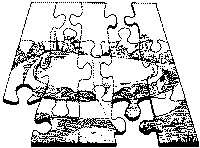THE MALDON BURH JIGSAW
For five years, the Maldon Archaeological Group has been trying to find the site of the Saxon burh or fort, built in 916 by King Alfred the Great's son Edward the Elder, as a defence against Danish invaders. In 1985, excavation in the back garden of No. 20 Spital Road showed that an earth bank is probably part of the burh defences, and may even be of prehistoric origin. With this discovery, other clues collected earlier are beginning to come together like the pieces of a jigsaw, some pieces fitting well and some not, whilst of course there are gaps in the picture which remain to be filled.
This booklet contains the jigsaw pieces available for reconstructing the plan of the burh. In so doing, it reports the progress of the Burh Research Committee and describes the excavations at 20 Spital Road. Included are some suggestions as to how and where we might look for more clues and a brief overview of Maldon's early development in the light of recent discoveries.

|
|
|
Documentary Evidence
912
..After that in summer, between Rogation and midsummer, king Edward
went with some of his supporters to Maldon in Essex, and camped there for the
time the borough was worked on and built at Witham. To him submitted a good
part of the folk who had been under Danish rule
.
|
Comment
The first jigsaw piece was provided by unknown writers of the tenth century. Appropriately it is also our earliest reference to Maldon and although the exact dating is disputed by scholars the Chronicles do indicate Maldon's importance and the part it played in early English history. The meaning of the word translated as 'borough' above has changed over the years and can be read here as 'burh', meaning Saxon fort.
Although the most obvious burh evidence is a record of its foundation by King Edward the Elder there are reasons for believing that in 916 Edward merely refortified a much earlier earthworks. In his campaigns against the Danes across the country it was a common thing to do and there is archaeological proof of this happening at Witham. The fact that Edward first came to Maldon in 912 implies that, even before the establishment of the burh, it was a more secure base than the ancient earthworks being refortified at Witham.
Success of the town's people to withstand a formidable assault by Danes and
Vikings in 917 testifies to the strength of the fortress.

|
|
|
.Offa fulfilled his former boast to Byrhtnoth, the ring-giver, that they
should either return unhurt, riding to the stronghold in victory together, or
together surrender their lives, bleeding from wounds on the battlefield
|
Comment
The event is best known from the famous old English battle poem which describes in detail the heroic battle, the death of the ealdorman Byrhtnoth and the defeat of the English. The Anglo-Saxon Chronicles also record the battle: -
|
991 .......In this year came Anlaf (Olaf Tryggvason) with ninety-three ships to
Folkestone and harried outside, and sailed thence to Sandwich, thence to
Ipswich, overrunning all the countryside, and so on to Maldon. Ealdorman
Byrhtnoth came to meet them with his levies and fought them, but they slew the
ealdorman there (10 August) and had possession of the place of slaughter.
Afterwards peace was made with them and the king stood sponsor for him (Anlaf)
at confirmation: this was dons on the advice of Sigeric, archbishop of
Canterbury. and Aelfheah, bishop of Winchester.... in the same year it
was decided for the first time to pay tribute to the Danes on account of the
atrocities they wrought along the sea coast. On this first occasion it amounted
to ten thousand pounds. This course was adopted on the advice of archbishop
Sigeric.
|
Comment
We have no reference to events in the town or burh immediately following
Byrhtnoth's bloody defeat but there are hints which suggest Maldon may have
escaped a disastrous sacking and that the burh's life as a defense against
invaders continued for some time afterwards. The town appears to have retained
its high status with its mint and Royal connections (1171 Charter).
|
|

|

|
